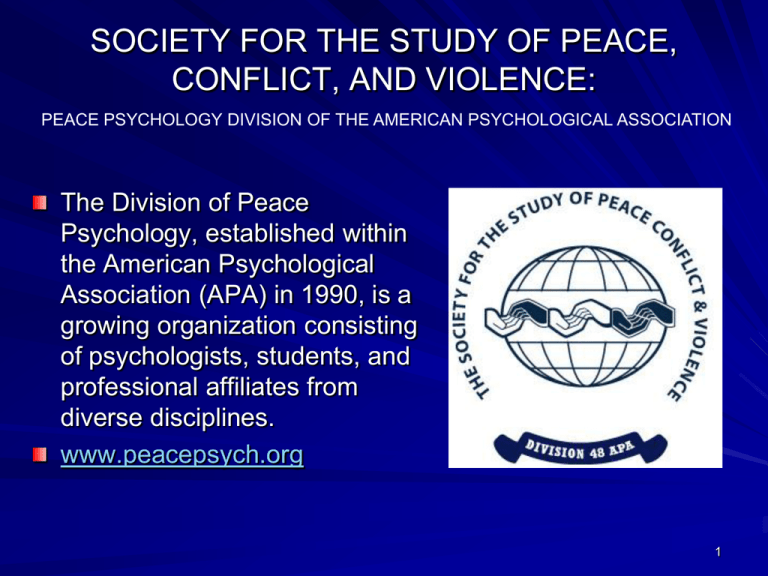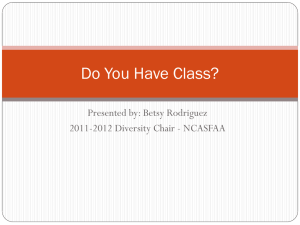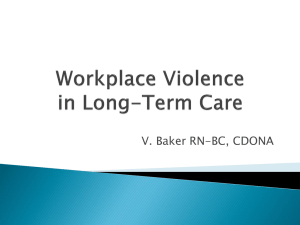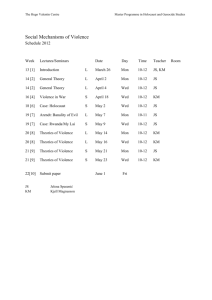Peace Psychology
advertisement

SOCIETY FOR THE STUDY OF PEACE, CONFLICT, AND VIOLENCE: PEACE PSYCHOLOGY DIVISION OF THE AMERICAN PSYCHOLOGICAL ASSOCIATION The Division of Peace Psychology, established within the American Psychological Association (APA) in 1990, is a growing organization consisting of psychologists, students, and professional affiliates from diverse disciplines. www.peacepsych.org 1 The specific goals of the Peace Division are: 1) to encourage psychological research, education, and training on issues concerning peace, nonviolent conflict resolution, reconciliation, and the causes, consequences and prevention of war and other forms of destructive conflict; 2) to provide an organization that fosters communication among researchers, teachers, and practitioners who are working on peace issues; and 3) to apply the knowledge and the methods of psychology in the advancement of peace, non-violent conflict resolution, reconciliation, and the prevention of war and other forms of destructive conflict. 2 Causes of Conflicts Limited Resources (time, money, property) Unmet Basic Needs (security, identity, material necessities, self-determination) Clashing Values (freedom versus equality) Beliefs (chosen people) Ideologies (capitalism versus communism) Levels of Conflict Intrapersonal or Intrapsychic (psychotherapist?) Interpersonal (marriage counselor?) intragroup (leadership?) intergroup (diplomacy?) interstate (world government?) Dealing with Conflicts Negotiation – Two or more parties working to resolve a conflict Mediation – Parties in a conflict are assisted by a third party Arbitration – Settlement imposed by a third party Responses to Conflict (psychological results) a. Withdrawing (self-destructive behavior) b b. Dominating (aggression) c. Submitting (depression) a b d a d. Engaging (healthy) e. Vascillating (anxiety) c c Nature of Violence Violence – The exertion of physical (or psychological) force that harms. Direct Violence – That committed by identifiable people on particular victims. Structural Violence – Harm that comes from subtle, gradual, systematized, normally accepted actions of particular social institutions where responsibility is blurred. (Determines who gets heard, who gets devalued and who gets resources.) Direct and Structural Violence manifest differently but are interdependent 7 Examples of Direct Violence Hate crimes Ethnic cleansing Rape Murder War Police brutality 8 Examples of Structural Violence Poverty Unemployment Discrimination (Racism, sexism, etc.) Poor health care, schools or housing Racial profiling Corrupt political system Poor accountability for misuse of power 9 Moral Exclusion Morals- Norms, rights, entitlements, obligations, responsibilities and duties that shape our sense of justice and guide our behavior with others. Moral Community- Those we value inside our “scope of justice”, family, friends, compatriots and coreligionists. “US” Morally Excludable- Strangers outside our scope of justice and enemies. “THEM” 10 Psychological Bases for Moral Exclusion Tendency to exclude is fostered by normal perceptual tendencies: 1. Social categorization 2. Evaluative judgments 3. Fundamental attribution error 4. Self-serving biases 5. Zero-sum thinking 6. Attributive projection 7. Just world thinking 11 To Foster Social Justice: 1. 2. 3. 4. 5. Welcome open dialogue and critique. Establish procedures that keep communication channels open during increased conflict. Value pluralism and measured acceptance of the different. Be alert to symptoms of moral exclusion. Challenge injustice constructively. 12 Recommended Reading Christie, D.J., Wagner, R.V. and Winter, D.D. (Eds.), 2001. Peace, Conflict, and Violence: Peace Psychology for the 21st Century. Upper Saddle River, NJ: Prentice Hall. Deutsch, M. and Coleman, P.T. & Marcus, E.C. (Eds.) (2006). The Handbook of Conflict Resolution: Theory and Practice. San Francisco, CA: JosseyBass. de Rivera, J. (Ed.), 2009. Handbook on Building Cultures of Peace. New York, NY: Springer. MacNair, R.M. (2003). The Psychology of Peace: An Introduction. Westport, CT: Praeger Publishers. Mayton, D.M. (2009). Nonviolence and Peace Psychology: Intrapersonal, Interpersonal, Societal, and World Peace. New York: Springer. 13 Credits The following psychologists contributed to development of this PowerPoint presentation: Dan Christie, Joe deRivera, Eduardo Diaz, and Linden Nelson. For more information about peace psychology, please visit <www.peacepsych.org>. 14











